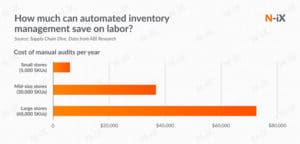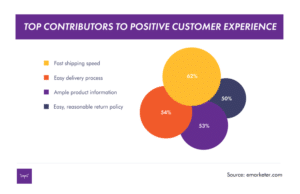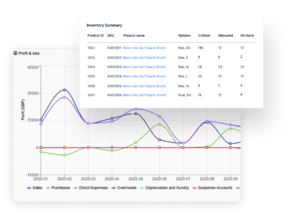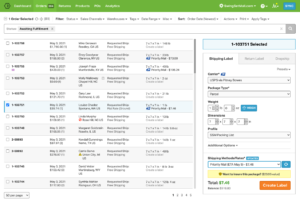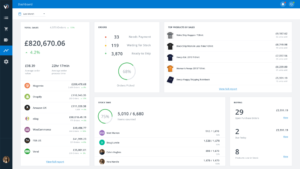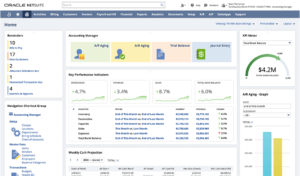Inventory management is a fundamental part of running a successful business. You need to accurately track and control your goods to avoid errors and maintain the right stock levels—and ultimately keep your customers happy and loyal.
Without a robust system in place, you could fall victim to issues like overstocking or insufficient stock—and your bottom line will take a hit. In this post, we’ll show you why inventory management solutions are so important, and why a Retail Operating System like Brightpearl can take you even further.
Why is Inventory Management Difficult?
Inventory management can be a bit of a headache for business owners. There’s no one-size-fits-all approach, because the type of system is dependent on the nature and size of the company. Each business has to set up and follow a system that suits its specific needs.
These days, you’re likely to be selling on multiple sales channels, which makes the task even more of a challenge. Then there are the fluctuations in the global supply chain to consider, as well as changes in customer demand. You need to forecast demand as accurately as you can, to avoid costly delays in getting items to the customer.
Here are some of the most common inventory management challenges you might face:
10 Common Inventory Management Challenges
1. Inaccurate Data
If you’re going to manage your inventory effectively, you need to know exactly what stock you have at any given moment (and where it’s located). A yearly stock take just isn’t going to cut it. Unless you use an inventory management solution, you’ll find it harder to get a handle on stock levels. And you won’t be able to make accurate forecasts.
If you’re selling on a third-party marketplace like Amazon, Ebay, or Etsy, you might experience issues with the visibility of your stock. Without all the data at your fingertips, you risk inaccurate or delayed shipments to customers or distributors. Not to mention the impact this will have on business cash flow!
2. Inconsistent Tracking
Many companies think they can get by with manual inventory tracking procedures, but for a large company it’s just not a viable option. If employees have to enter tracking information manually across spreadsheets or on different software, it’s tedious, time-consuming, and eats into their productivity.
It’s also highly prone to errors. All it takes is for someone to make a typo with the numbers, and suddenly it looks like you have 10,000 items in stock when it’s actually only 1,000. In this scenario, you’d end up not being able to fulfil the extra orders you took before the mistake was discovered. A centralized asset tracking system can help you avoid such pitfalls.
Source: n-ix.com
3. Warehouse Management
Managing space for your physical inventory is a mammoth task. You need to ensure there’s enough room for bulky items or extra stock at times of high demand—but on the other hand, you don’t want to be paying for space you don’t need.
Warehouse inventory control is labor-intensive, with stages including receiving and putaway, picking, packing, and shipping. If the system is not efficient, it can have a big impact on sales forecasts and other crucial aspects of your business.
Warehouse management systems are useful here, but they shouldn’t be confused with complete inventory management systems. Planning and designing your warehouse spaces with an inventory management platform is more beneficial to overall asset management.
4. Order Management
Order management is a bit of a minefield. You’ve got to be able to deliver (literally) on the promises you make to your customers, or you risk losing them. Over 70% of online shoppers would search for an item elsewhere if it was unavailable, rather than wait any length of time for it to come back into stock.
Although you’re at the mercy of global supply chains, there are steps you can take to mitigate against delays. Efficient order management is crucial to your operations, including automated ordering, fulfillment, shipping, and invoicing.
This should form part of your inventory management solution, which will also help you keep tabs on changing availability and demand. Ideally, you need a system that helps you create order strategies for core items, as well as the ability to view purchase orders and sales orders alongside other information in a single database.
5. Inefficient Processes
Companies with limited inventory and a single warehouse location often use manual procedures to manage operations. But as your business grows, your sales volume will increase and your inventory will expand. This is a good thing for your business, of course—but it means you’ll need to optimize your processes.
Inefficient, low-tech procedures are much more difficult to scale across multiple warehouses with lots of stock, while physical paperwork can easily go astray and lead to delays. Plus, if you don’t use automation for things like scanning SKUs and serial numbers quickly, doing stock takes and locating items will be very time-consuming.
6.Problematic Stock
Some items are simpler to store and control than others. If you’re carrying stock that’s especially fragile or perishable, you have to think about specialized care and storage. Developments in packaging have also raised new considerations for warehousing, as eco-friendly items may need to be stored differently.
For high-value inventory, you’ll need loss-prevention strategies and controls in place. And if you do experience inventory loss (due to things like spoilage, damage, or theft) then you require a system that helps you identify and track problem areas to make sure it doesn’t happen again.
Whether you use the FIFO (First In, First Out) or LIFO (Last In, First Out) method, it still makes sense to use a dedicated inventory management solution.
7. Increasing Competition
It’s an increasingly competitive world, and customers won’t hesitate to go elsewhere if the service they receive isn’t up to scratch! In fact,50% of customers would switch to a new brand after one bad experience. Keeping on top of inventory management is critical to the success of your business, so that you can outperform your competitors and retain your clients.
The challenge is to meet their demands by controlling your inventory. But it’s not just about knowing your customer and anticipating busy times like the holiday season. Unpredictable market forces and globalized supply chains have an impact on demand for raw materials, so you may find yourself in competition for products that suddenly become more scarce.
8. Lack of Expertise
This is a real challenge for businesses, no matter how good (or bad) their inventory control system is. Employees have to be well-trained in order to understand how the system works and be able to use it efficiently, especially when there’s smart technology involved.
IYou need to ensure that any inventory management solution you choose offers robust onboarding and a high level of ongoing support and training.
9. Poor Communication
Lack of communication is detrimental to any business. In ecommerce, it’s particularly important for different departments to share information and keep each other in the loop. But it can be difficult to ensure that everyone (buyers, warehouse managers, customer support teams) takes a collaborative approach.
If communication is lacking, it’s much harder to spot negative inventory trends or issues and find ways to improve the system. The technology you use plays a big part here, as certain platforms and apps are better than others at gathering and sharing data.
10. The Wrong Software
Maybe your company has already made the move to inventory management software. But unless you’ve chosen the right package for your needs, you might find that it’s not really doing the job you intended it to do.
There are hundreds of advanced inventory management solutions out there, which means the task of choosing the right software takes some careful research. Unless it can support complex logistics and integrate with your existing process platforms, it may turn out to be more of a hindrance than a help.
How do You Manage Inventory Effectively?
So, we’ve looked at the many challenges of inventory management, but what can you do to overcome them?
Well, it’s likely that at least some of your processes require optimization to get things running smoothly. A system that can automatically track inventory within the supply chain will maximize efficiency, while tracking metrics for lead times, safety-stock levels, and reorder points will help you with forecasting.
Choose a solution that offers a dashboard with real-time inventory data, and syncs with essential productivity and communications tools. If you also automate laborious tasks with barcode scanners for fast identification) then it’ll be simpler to streamline your operations.
The Best Inventory Management Techniques
The good news is that there are a number of inventory management techniques you can use to improve your supply chain management operations. We’re going to take a look at three of the best—although you don’t have to choose just one!
Many companies use a hybrid model that combines elements from different strategies. Using inventory management software will help you judge which is most suitable for your business, and help you implement it successfully.
Just-In-Time Strategy
As its name suggests, this strategy sees businesses order their inventory “just in time” to fulfill a customer’s request. Products are only ordered according to demand, and the stock arrives either just before or exactly at the time it’s needed.
This method is popular with retailers because it reduces the need for large warehouse spaces and helps keep costs down. Because the inventory doesn’t have to be stored for so long, it’s less likely that you’ll be left with obsolete stock, especially in the fast-paced worlds of fashion and technology.
However, since stock is not ordered until it’s been requested, this can lead to delays in delivery. And you might have to overpay for a product in order to meet demand, if you haven’t made an accurate forecast.
Push Strategy
Source: Industryweek.com
The push strategy is when a business procures its stock based on expected demand, instead of waiting for a customer to place an order. Items are effectively “pushed” down to the store or warehouse, and customers purchase them from the existing inventory.
For example, retailers know that items like snow shovels and warm jackets will only be required in the fall and winter. They can confidently order them (and advertise them) ready for the colder months, as that’s when customer demand will peak.
But if demand isn’t as high as you expected (maybe it’s an unseasonably warm winter), you could be left with excess inventory, which drives down the overall cost of the product. To use the push strategy, you need to understand customer needs and make accurate forecasts based on previous sales—which you can do in Brightpearl.
Pull Strategy
This is similar to the just-in-time method, in that inventory items are “pulled” from the warehouse or store only when customers request them. The strategy is most often used for high-value and specialty items, such as wedding dresses or the latest iPhone. Retailers don’t keep many of these items in stock, but they know they have customer appeal.
This two-way street of supply and demand is also a way of keeping storage costs low. However, it can be tricky to adjust order levels to keep up with shifts in consumer demand. And since it can take a while for specialty products to reach the customer, they may be able to get them quicker from elsewhere.
Importance of Inventory Management Solutions
Inventory management is a tough gig, with a lot of plates to keep spinning. You need to track your inventory at every stage of its journey through the supply chain. You need to manage the warehouse to avoid overstocking or running out of stock. And you need to make accurate forecasts for future demand.
As we mentioned earlier, it makes no sense to handle any of this manually. Manual inventory data is often stored in different places, making it hard to find—and it will probably contain errors. Inefficient warehouse operations lead to delays, which leads to unhappy customers. And inaccurate records during an official audit can even earn you a fine!
To ensure your operations are as efficient as possible, you’re going to need an advanced retail operating system like Brightpearl. As well as speeding up processes with automation, you’ll have greater visibility of your inventory thanks to real-time tracking. You can then make more informed decisions to grow the business.
How to Choose The Best Inventory Management Solutions For Your Business
Run a quick Google search on “inventory management” and you’ll be swamped by results from companies offering solutions. Some will offer free plans with basic tools; others will promise full functionality (for a price). Make sure you narrow the field to look at vendors who specialize in retail inventory management and understand the requirements.
The right inventory solution should incorporate essential and advanced features like tracking, automation, forecasting capability, and smooth integrations with other tools. You’ll need to judge the various options based on scalability, capability, and overall quality, as well as price.
Questions to Ask When Choosing Inventory Management Solutions
Before you start doing the research into possible solutions, it’s helpful to think about what you’ll need from the software. Here are some of the questions you might want to ask:
What Are Our Business Challenges?
The type of solution you choose will depend on the unique requirements and goals of your business. Maybe you’re about to make the transition from a manual system, or perhaps you’ve outgrown the basic inventory management system you used when you started out as a small business.
You might also be facing particular challenges such as running out of stock or delays in pulling items from the warehouse. Or you could be aiming for a specific goal, such as reducing overheads or offering shorter shipping times.
What Features Do We Need?
Again, this will be dependent on your individual needs. If it’s your first foray into inventory management systems, you might be looking to start small and see how you get on with the technology. Or you may decide to go the whole nine yards and pick a system with every possible feature. Some businesses will also have industry-specific requirements they need to meet.
As well as tracking inventory levels, it’s good to have an analytics function for gathering data and making predictions. Inventory management software can also include automation such as barcode scanning capabilities and real-time alerts to reduce errors, stock issues, and delays.
Is it Server-Based or Cloud-Based?
There are two options for the way your inventory management solution is owned and operated. You can either host it yourself on your own on-premises servers or you can go for the cloud-based type. With the former, you have full ownership of your software solution, but you’ll have to budget for the equipment and maintenance.
Cloud-based software, on the other hand, is hosted and maintained by a vendor. You don’t need any hardware, so you avoid large capital expenditure. In the SaaS (software as a service) model from companies such as Brightpearl, the product is effectively “rented” on a pay-as-you-go basis.
Does it Integrate Well With Existing Software?
You’ve probably already got back-end office systems in place, such as accounting software or other tools. Your inventory management solution should be able to integrate smoothly with these platforms, to save you having to manually bring in data from different sources.
It’s also worth checking that the software is available across a range of devices and operating systems, as your team will need to view the data on mobile devices as they move around the warehouse.
What’s The Support Package Like?
When you’re investing in any new technology, you need to know that you can access quality customer support as and when you need it. Ideally, you should choose a vendor that offers 24/7 support via a variety of contact methods (like Brightpearl).
You don’t want to be in a situation where a glitch with the tech leads to delays (for instance, if you can’t send out any products until the issue is fixed). It’s also essential that the package includes onboarding and training on how to use the system, so that managers and staff can quickly implement it across your business.
What Do Other People Think of it?
Don’t just take the vendor’s word for it that their solution is excellent. As well as looking at the testimonials and customer stories on their website, make sure you check out plenty of independent reviews and ratings.
Find out what other firms in your industry thought of their experience with the product. Was it simple to install and use? Was the billing process easy to understand? How did they get on with customer support?
The Best Inventory Management Solutions
“Best” is a relative term. The solution that’s best for someone else may not necessarily be the best fit for your business. And when it comes to pricing, your perception of the “best price” will also differ wildly depending on what you’re looking for and what you’re willing to pay.
Pricing for inventory management systems can vary greatly. It depends on the features you need, how customizable you’d like the software to be, and the level of customer support you’re looking for. Some vendors offer free trials, which is a good way to check if the solution is right for you.
Some even offer free plans (like Zoho Inventory), but those are very unlikely to meet the needs of larger businesses. Below, we’ll look at three of the most popular solutions on the market, and explore why none of them quite measure up to Brightpearl.
Ordoro
Source: Capterra.com
Ordoro is an all-in-one platform aimed at streamlining ecommerce operations, including inventory management. Its most notable functions are the large library of integrations and the shipping features, including discounted shipping options with USPS. It also has a range of easy-to-use stock management tools and an analytics dashboard.
There are plans for various sizes of business, starting at $499 per month for the Pro tier with inventory management and shipping included. The shipping-only Express option is offered from $59 per month, which may be suitable for smaller sellers or those who want to test the water before committing to a full system. Custom-priced plans are available for large enterprises.
The thing is, Ordoro just doesn’t have as many advanced features as Brightpearl. For example, in terms of accounting, it doesn’t have the built-in landed cost management that you get with Brightpearl.
Certain features, such as warehouse integration, are outside of the core plan so you have to pay extra. Similarly, onboarding support is available on all plans but does incur an extra fee. There’s no live chat option either.
Surprisingly, among the many integrations, there isn’t one for Zapier—which would have allowed users to connect apps that are not directly supported by Ordoro. Also missing from the list of tools is a mobile app (although it’s possible to access the dashboard through a mobile browser).
Veeqo
Source: Capterra.com
Veeqo is a cloud-based, multi-channel inventory management solution that allows you to sync inventory across sales channels and display everything on one dashboard. It’s available on a range of devices.
There are four different plans, all payable annually or monthly. The lower two (which are also available as a 14-day free trial) cost $55 and $120 per month respectively. That may sound like a good deal, but the functionality is unlikely to be robust enough for larger companies.
You’ll also find that several features are not available unless you choose the higher plans. And even then, you may still have to pay extra (the Veeqo barcode scanner incurs an extra cost even at Enterprise level, as does the QuickBooks integration).
The inventory forecasting and reporting features are fairly basic, and it doesn’t support advanced order fulfillment workflow automation. Unlike Brightpearl, Veeqo doesn’t have integrated real-time accounting or business intelligence—nor its own POS (point of sale) app.
Some users have noted that the dashboard doesn’t always keep you in the loop about how the data is being organized. Veeqo does offer 24/7 customer support, but that doesn’t include unlimited technical support. Plus, you only get a Customer Success Manager in the top tier.
Netsuite
NetSuite is a cloud-based ERP (Enterprise Resource Planning) solution that comes with a raft of business management features. Just like Brightpearl, it incorporates financial management and a CRM—and it also offers a tailored pricing model.
The main downside is that it isn’t specifically retail-focused. Ecommerce businesses may find that NetSuite’s features aren’t geared toward them, and you could wind up paying for a lot of functions you don’t actually need or use.
While the software is highly customizable, it takes time and technical know-how to configure it to your requirements. Brightpearl, on the other hand, already has plenty of features specifically aimed at ecommerce firms, so everything’s ready for you to get started. As well as this, Netsuite (like most ERPs) has an average implementation time of 420 days compared to 120 days with Brightpearl.
Some users have found NetSuite’s dashboard to be overly complicated and difficult to use, while integration bugs with third-party platforms have been known to cause downtime. In terms of customer support, subscribers can choose between Basic and Premium levels—so basically, you have to pay more if you want the highest-quality support.
Why Choose Brightpearl?
Brightpearl is a cloud-based retail operating system, designed especially for ecommerce retailers, wholesalers, and multichannel brands. The enterprise-level features include advanced tracking, forecasting, and analytics tools, automated order fulfilment, and multi-location/multi-currency inventory control.
Unlike most standalone inventory management solutions, Brightpearl provides integrated Inventory Planner, a data-driven inventory planning tool that ensures you have the right products and the right amount of stock on hand, so you can avoid the perils of over or under-stocking. It provides you with various forecasting and replenishment reports based on meaningful KPIs, such as stock on order, seasonality, profitability, and much more. So you can make more accurate forecasting faster.
Brightpearl is also a hyper-scalable system. It offers Plug & Play integrations to the top ecommerce platforms, marketplaces, 3PL, shipping & accounting options meaning you can get up and running within minutes. These integrations to solutions like: Shopify, Shopify Plus, Bigcommerce, Magento, eBay, Amazon, Xero, and multiple 3PL & shipping options are powered by a ultra-fast API that can handle huge volumes so you can deal with peak seasonality with ease.
The modular pricing structure is straightforward, customized to your requirements and based on order volume. Brightpearl wants to help you grow so as your orders increase, your cost-per-order goes down so you’re not punished for moving your business forward.
Why You Need an Inventory Management Solution
You’ve hopefully realized from this post that effective inventory management is crucial to the success of a retail business. Compared with outdated manual systems, advanced inventory management solutions have the power to revolutionize your business and boost your bottom line.
One of the most important elements is the reduction in human error. By automating tedious processes such as data entry and product identification, productivity will improve and you’ll be much less likely to experience issues with stockouts. That means fewer delays, which translates to increased customer satisfaction and loyalty.
With advanced tracking options, you’ll be able to see exactly what you have and where it is, at any given time. This makes it much easier to make accurate predictions, helped by smart forecasting tools. Having excess stock (or not enough) should then become a thing of the past.
If you want an inventory management system that helps you fulfil orders accurately and swiftly every time, you don’t need to look any further than Brightpearl. The Automation Engine is so efficient at streamlining processes and speeding up workflows that it can save your company two months a year on average!
There’s also automation for dropshipping, fulfilling from multiple locations, and creating purchase orders. Meanwhile, the analytics center uses the inventory tracking data to create advanced reports covering channel-specific performance, demand forecasting, and customer analysis.
To find out more about how Brightpearl takes the frustration out of inventory management, get in touch for a demonstration and a chat with the friendly sales team.
Frequently Asked Questions (FAQs)
What is The Main Purpose of Inventory Management?
Inventory management is a method used by retail businesses to make sure the ordering, storing, and distribution of inventory is as efficient as it can be. It helps you maintain the right stock levels in the right places, so that you have enough goods or materials to meet demand without creating excess stock or running out of items.
How Do You Control Inventory?
It’s important to track your inventory at every stage, and keep accurate records. That way, you’ll know how much stock you have in each warehouse, what’s already been shipped, and which items are currently on route from your suppliers.
To audit your inventory, you could use either a perpetual or periodic inventory system. Perpetual inventory systems continually update inventory records whenever items are received, sold, moved, picked, or scrapped. This means the information you receive should be completely up-to-date.
Within this system, companies can use a barcoding system. This updates inventory levels automatically when workers scan items with a barcode scanner or a mobile device. Even more advanced is the RFID (Radio Frequency Identification) system, where tagged items trigger a sensor as they pass by on their way in or out of the warehouse.
Perpetual systems do require specialized equipment and software. Plus, the information may not accurately reflect actual inventory over time, unless you also undertake periodic physical inventory counts.
Periodic inventory systems record inventory levels over a set period of time, in which the stock is physically counted. They don’t require much in the way of technology, but that means there may be more errors (or even fraud or theft).
It’s harder to keep an eye on stock levels without continuous control, so this method is better suited to smaller businesses. And physical inventory counts are time-consuming—some firms have to suspend normal business activities while the audit takes place.
Why Use Inventory Management Solutions?
There are many benefits to using inventory management solutions, including a reduction in human error. They massively increase a company’s efficiency, with automation making processes faster and workers more productive.
Inventory management systems gather data to help you manage the supply chain, optimize order times, and see which products are most popular. Companies can reduce expenses by keeping less stock in warehouses, while ensuring that they don’t face shortages and upset their customers.
The data also provides an overview of how the business is doing, with insights from intelligent reporting on sales data and reorder levels. This can be used to forecast demand and order stock accordingly.


